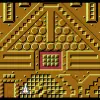More like this...
wonderboy _twr Commodore 64 game
Description
Wonder Boy is a classic Jump 'n' Run game that Sega originally released as an arcade game in 1986. In the game, players control a character known as "Wonder Boy" as he traverses scrolling landscapes with the goal of rescuing his girlfriend. However, this journey is fraught with dangers including chasms, boulders, fires, and various hostile animals. Along the way, players discover useful items such as "surprise eggs," which grant special abilities, and a variety of fruits that restore the character's life energy upon collection.
Design
Gameplay Impressions
The game features smoothly scrolling levels from left to right, boasting bold graphics and fluidly animated colorful sprites. It is divided into seven areas, each consisting of four rounds, which in turn are composed of four parts. After completing each area, players confront an end boss. The game's graphics remain consistent throughout its progression. An endless background tune accompanies gameplay if enabled. Additionally, the game includes audio cues for shooting, jumping, and collecting food.
Gameplay Hints
Wonder Boy must navigate various platforms and gaps while defeating animals encountered along the way. To maintain energy levels, he can gather food items like fruits, sweets, or sandwiches scattered throughout the game. Obstacles like fires and rocks can also impede progress.
An upper bar on the screen displays relevant information, such as the remaining lives (indicated by yellow symbols), carried items (including the axe), and energy status (depicted as an energy bar). Players must keep the energy bar from depleting to prevent "No Vitality" and subsequent loss of life. The current score for the player or high score is also displayed.
Instructions
Controls
Keyboard controls:
- F1: Single-player mode
- F3: Two-player mode
- F5: Toggle music on or off
- F7: Pause
- Z: Move left
- X: Move right
- Equal (=): Jump
- SPACE: Walk/jump quickly and throw axe
Joystick controls:
- Joystick left: Move left
- Fire button press: Move right
- Joystick forward: Jump
- Fire button press: Walk/jump quickly and throw axe
Animals and Obstacles
The game features various animals and obstacles that players encounter:
- Snail
- Snake
- Wasp
- Native (small blue men)
- Spider
- Frog
- Bat
- Squid
- Rock
- Rolling stones
- Fire
Helpers and Elements
Players can also interact with different elements:
- Egg (contains various items)
- Energy potion
- Doll (doubles points for remaining energy at the end of a round)
- Extra life
- Spring (used for long jumps)
End Boss
Players face end bosses at the conclusion of each area. Defeating an end boss requires a specific number of hits, which increases with higher areas. After defeating an end boss, players collect an item and proceed to the next level.
Tips
- Utilize the appearing food items to maximize playtime.
- Obtain and retain the axe to eliminate enemies.
- Defeat each end boss by targeting its head with a certain number of hits.
- Successfully defeating the seventh end boss concludes the game, leading to a bonus and rescue of the girlfriend.
Cheats
Interrupt the game with RESET, then type POKE 2676,205, and restart the game with SYS 2112. The Remember version offers additional options such as energy loss prevention, unlimited lives, permanent axe possession, and more.
Reviews
Opinions among reviewers varied:
- Jodigi noted the game's fun and tricky situations, praising its music but highlighting some monotony.
- Shakermaker303 found the game enjoyable as a casual Jump & Run experience but not a standout title.
- Helmutx enjoyed the arcade version more, finding the C64 conversion less successful.
- Camailleon appreciated the familiarity of the game, considering it a solid Jump & Run with moderate difficulty.
Miscellaneous
- The arcade version showcased more intricate graphics than the C64 conversion but retained the game's essence.
- Different versions were released for various platforms, including the SEGA Master System.
- The game's cover art and scenes from various versions were compared.
Highscore
- Camailleon achieved a top score of 491,960 points.
Solution
- Players should consume food items for extended playtime and keep the axe to eliminate enemies.
- Defeating end bosses requires targeting their heads with specific hit counts.
Cheats
- Players can input the POKE command 2676,205 after resetting the game.
Voting
- C64-Wiki users rated the game 7.49 out of 10 on average.
- Other review scores ranged from 6.78 to 8, with various strengths and critiques highlighted.
Reviews
- Reviewers offered mixed opinions on the game's gameplay, difficulty, and appeal.
Comparison with Other Versions
- The original arcade version boasted more intricate graphics than the C64 version but retained the gameplay essence.
Cover Art
- The disk and datasette version's cover art was showcased.
Highscore
- Camailleon achieved a top score of 491,960 points.
Cheats
- A cheat involving a POKE command was provided.
Final Rescue and Conclusion
After defeating the seventh end boss and rescuing the girlfriend, the game concludes.
Game category: Commodore 64 games
Wonder Boy, originally released by Sega in 1986, is a cherished classic in the platform adventure genre. Developed by Escape (now known as Westone Bit Entertainment), this game quickly became an iconic title that captured the hearts of gamers around the world. Over time, it found its way onto various gaming platforms, ensuring that a wide audience could enjoy its charms. Let's delve deeper into what makes Wonder Boy an enduring classic.
At its core, Wonder Boy is a tale of heroism and rescue. The player assumes the role of the titular Wonder Boy, a tribal caveman-like character with a heart full of determination. His mission is straightforward yet compelling: to rescue his beloved girlfriend, Tina, who has been abducted by the nefarious King. This classic "damsel in distress" plot sets the stage for an unforgettable adventure.
The game world is divided into seven distinct areas, each comprising four rounds. These areas are not merely cosmetic changes but present unique challenges and environments, keeping players engaged throughout their journey. Wonder Boy's path to rescue Tina is strewn with an assortment of obstacles and dangers, including rolling boulders, blazing bonfires, malfunctioning elevators, and daring leaps that test the player's platforming skills.
To aid in this perilous quest, Wonder Boy can equip himself with several essential items. The stone hatchet, for instance, serves as both a defensive weapon and a tool for dispatching oncoming foes. Throwing this hatchet adds an element of strategy, as its trajectory requires precise timing and aim to defeat enemies standing directly in front. Additionally, players can discover and utilize a skateboard, which provides both speed and a layer of protection, enabling Wonder Boy to glide swiftly past adversaries. However, mastering the skateboard's control can be challenging, and a mishap can lead to an unfortunate collision with an enemy.
One of the more distinctive aspects of Wonder Boy is the introduction of temporary protection by guardian angels. This unique power-up allows Wonder Boy to turn the tables on foes by running into them. It adds a dynamic twist to the gameplay, as players must strategically time their angelic assistance to maximize its effectiveness.
Throughout the adventure, Wonder Boy can also indulge in collecting various food items. These morsels serve a dual purpose: they boost his vitality and act as a timer of sorts. Given the game's unforgiving nature, with hazards that can instantly claim a life, the vitality meter often offers a slim margin for error. This feature challenges players to carefully manage their health while navigating treacherous terrain.
Egg pods are another intriguing gameplay element. These pods contain either a stone hatchet or a skateboard, providing players with valuable tools for overcoming obstacles. Cracking open these pods adds an element of strategy to the game, as the trajectory of the hatched item can be unpredictable. Mastering the skill of precise jumps to control the item's direction becomes crucial, especially in later, more challenging stages.
Despite the limitations of the hardware of its time, Wonder Boy manages to offer a diverse and engaging gaming experience. The game's levels showcase a surprising degree of creativity, considering the era it was developed in. The varied environments and obstacles keep players on their toes, ensuring that each stage feels fresh and exciting.
However, it's worth noting that the game's graphics, while serviceable, don't fully exploit the potential of the hardware's low-resolution multicolor mode. This serves as a reminder of the constraints that game developers had to work within during this period.
In conclusion, Wonder Boy stands as a testament to the enduring appeal of classic platform adventure games. While it may not have pushed the boundaries of its genre, it has rightfully earned its place in gaming history. Its accessible yet challenging gameplay, memorable character, and engaging levels have left an indelible mark on the gaming community. Whether experienced on an arcade machine, Sega console, or various home computers, Wonder Boy continues to be a beloved classic that has stood the test of time.
Recently played



Comments